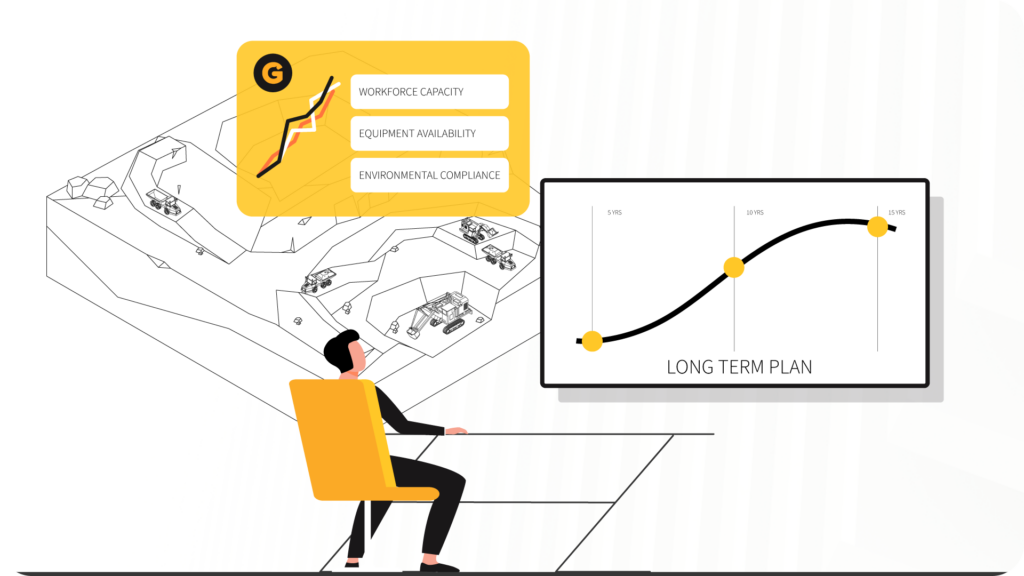The Importance of Strategic Long-Term Mine Scheduling
Long-term mine scheduling is essential for strategic business objectives and short term scheduling should be aligned with long term scheduling. Unlike short-term scheduling, which focuses on operational tasks, long-term scheduling involves planning the extraction sequence over the entire life of the mine. This process requires a comprehensive understanding of orebody characteristics, equipment capacity, environmental regulations, and market dynamics. A well-crafted long-term schedule not only maximizes profitability but also ensures the sustainability of mining operations.
The foundation of long-term scheduling lies in resource estimation and orebody modeling, where geologists analyze geological data to determine the distribution and quality of mineral resources. Accurate orebody models form the basis for defining extraction sequences that prioritize high-grade ore while minimizing operational costs. Modern mine operation planning tools, including GroundHog, integrate real-time geological data to ensure that long-term schedules remain aligned with changing conditions.
Once orebody models are established, mine planners develop life-of-mine (LOM) schedules that outline the extraction sequence over several years or decades. These schedules account for factors such as equipment availability, workforce capacity, and environmental compliance. GroundHog’s advanced analytics empower mine planners with critical operational insights. With these insights mine planners can simulate multiple scenarios and assess their impact on long-term profitability. By evaluating different extraction paths, planners can identify the most cost-effective approach that maximizes resource recovery and minimizes environmental impact.
GroundHog’s scheduling capabilities extend beyond static long-term plans by incorporating real-time data and predictive insights. For example, if changes in market demand or commodity prices require adjustments to production targets, GroundHog’s dynamic scheduling tools enable planners to recalibrate extraction sequences accordingly. This level of adaptability ensures that long-term plans remain aligned with evolving business goals and market conditions.
Moreover, GroundHog facilitates collaboration between geologists, engineers, and operations managers, ensuring that long-term schedules are developed with input from all key stakeholders. This collaborative approach enhances decision-making and minimizes the risk of misalignment between operational and strategic objectives.
As the mining industry continues to evolve, the ability to develop and maintain flexible long-term schedules is becoming increasingly critical. GroundHog’s data-driven approach empowers mine operators to maximize profitability, optimize resource utilization, and ensure the long-term sustainability of their operations.
Effective long-term mine scheduling is the cornerstone of strategic mine planning, enabling operators to make informed decisions that shape the future of their mining operations. As mining companies strive to optimize life-of-mine (LOM) planning, the ability to develop adaptable, data-driven schedules becomes increasingly valuable—especially in a fluctuating market and evolving regulatory landscape.
Laying the Groundwork: Long-Term Mine Scheduling Through Resource Estimation and LOM Planning
A robust long-term schedule begins with accurate resource estimation and detailed orebody modeling, which allow planners to prioritize high-grade zones and optimize the timing of extraction. Tools like GroundHog mine planning software empower teams with real-time geological data and advanced scheduling capabilities to build schedules that are both strategic and executable.
What sets GroundHog apart is its ability to seamlessly connect long-term scheduling with short-term operational planning. By integrating production data, equipment telemetry, and market inputs, GroundHog ensures that the LOM schedule remains responsive to on-the-ground realities. If commodity prices change or operational constraints arise, GroundHog’s dynamic mine scheduling tools enable real-time scenario modeling, allowing planners to quickly adjust extraction sequences to maintain profitability and compliance.
This integrated approach fosters collaboration between geologists, engineers, and operations managers—ensuring that decisions are aligned across all departments. With predictive scheduling and data-driven insights, GroundHog not only enhances operational efficiency but also supports sustainable mining practices by minimizing waste and improving resource utilization.
As the mining industry faces increasing pressure to deliver value while minimizing environmental impact, investing in intelligent mine scheduling software like GroundHog is no longer optional—it’s a strategic imperative for long-term success.
